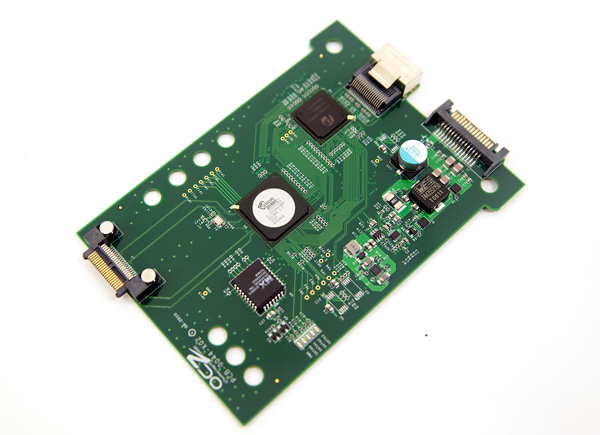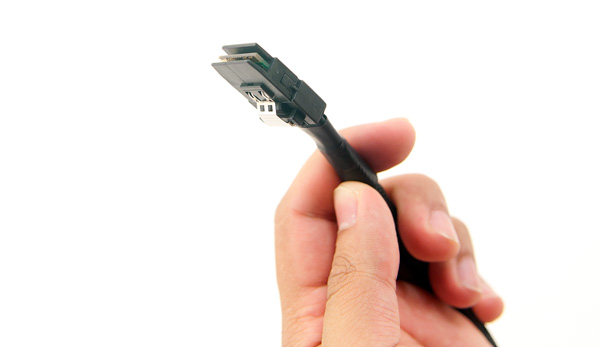OCZ's Fastest SSD, The IBIS and HSDL Interface Reviewed
by Anand Lal Shimpi on September 29, 2010 12:01 AM ESTFinal Words
The OCZ IBIS is very fast as you’d expect. Technically it’s the fastest SSD we’ve ever tested, but that’s because it’s actually four SF-1200 SSDs in a single 3.5” chassis. From a cost standpoint you’re better off grabbing four SandForce drives and rolling your own RAID, but if for whatever reason you don’t want to do that then a single IBIS will get the job done. It's faster than a Colossus by a huge margin and even faster than OCZ's recently introduced RevoDrive, you just need the workload to stress it.
I’m very comfortable with SandForce as a controller when it comes to not having TRIM. The IBIS’ garbage collection is aggressive enough to fix any significant fragmentation with a bit of idle time.
As I mentioned earlier however, the real goal here is to RAID multiple IBIS drives together with the 4-port card. We measured maximum sequential throughput of 675MB/s for a single IBIS drive, assuming somewhat linear scaling you can expect over 2.5GB/s out of a 4-drive IBIS array. This would be all off of a single PCIe x16 card. At this point the 4-port cards aren’t bootable, OCZ believes it is still several weeks away from having that support enabled.
Introducing a new interface is a very bold move for a company whose start was as just another memory vendor. I asked Ryan if motherboard manufacturers were signed up to deliver boards with HSDL connectors, he said they were. Although motherboard manufacturers often agree to do a lot that doesn’t end up being a launched, retail product. Motherboard makers aren’t the only ones who have taken notice as apparently RAID card manufacturers also want a piece of the HSDL pie. All of this is completely up in the air at this point. It’s one thing to mention you have lots of interest, it’s another to point at a mature market with products actually launching. Getting any company, much less a motherboard or RAID card manufacturer to commit resources to delivering features that support a market of zero is a tall order. I’m not saying it can’t be done, I’m saying that if Ryan Petersen can achieve it, he will have been the first to do it among a long list of memory companies who tried to be something more.
Ryan and OCZ are doing what they’re good at: finding a niche and trying their best to get there quicker than the big guys. There’s simply no PCIe SSD standard for the high end. For a single PCIe SSD there’s not much need, but if you want to RAID together multiple PCIe SSDs you’ll either run out of PCIe slots or have a very fast, very unbootable RAID.
The HSDL standard is completely open. OCZ tells me that there’s no licensing fees and all companies are completely free to implement it. In fact, that’s what OCZ would like to see happen. Currently the only way to get the HSDL spec is to contact OCZ and request it but the company is apparently working on setting something up a little more open. At the end of the day OCZ still wants to make money selling SSDs. HSDL’s success would simply let the company sell more expensive SSDs.
Drives will be available in two weeks but let's hope some of these integrated motherboard designs pan out.
HSDL sounds like a simple solution to the problem of delivering more interface bandwidth to SSDs. The interface should scale well since it’s built on PCIe, it’s just a matter of whether or not companies will support it. I believe it’s at least worth a try.












74 Comments
View All Comments
jwilliams4200 - Wednesday, September 29, 2010 - link
Anand:I suspect your resiliency test is flawed. Doesn't HD Tach essentially write a string of zeros to the drive? And a Sandforce drive would compress that and only write a tiny amount to flash memory. So it seems to me that you have only proved that the drives are resilient when they are presented with an unrealistic workload of highly compressible data.
I think you need to do two things to get a good idea of resiliency:
(1) Write a lot of random (incompressible) data to the drive to get it "dirty"
(2) Measure the write performance of random (incompressible) data while the SSD is "dirty"
It is also possible to combine (1) and (2) in a single test. Start with a "clean" SSD, then configure IO meter to write incompressible data continuously over the entire SSD span, say random 4KB 100% write. Measure the write speed once a minute and plot the write speed vs. time to see how the write speed degrades as the SSD gets dirty. This is a standard test done by Calypso system's industrial SSD testers. See, for example, the last graph here:
http://www.micronblogs.com/2010/08/setting-a-new-b...
Also, there is a strange problem with Sandforce-controlled "dirty" SSDs having degraded write speed which is not recovered after TRIM, but it only shows up with incompressible data. See, for example:
http://www.bit-tech.net/hardware/storage/2010/08/1...
Anand Lal Shimpi - Wednesday, September 29, 2010 - link
It boils down to write amplification. I'm working on an article now to quantify exactly how low SandForce's WA is in comparison to other controller makers using methods similar to what you've suggested. In the case of the IBIS I'm simply trying to confirm whether or not the background garbage collection works. In this case I'm writing 100% random data sequentially across the entire drive using iometer, then peppering it with 100% random data randomly across the entire drive for 20 minutes. HDTach is simply used to measure write latency across all LBAs.I haven't seen any issues with SF drives not TRIMing properly when faced with random data. I will augment our HDTach TRIM test with another iometer pass of random data to see if I can duplicate the results.
Take care,
Anand
jwilliams4200 - Wednesday, September 29, 2010 - link
What I would like to see is SSDs with a standard mini-SAS2 connector. That would give a bandwidth of 24 Gbps, and it could be connected to any SAS2 HBA or RAID card. Simple, standards-compliant, and fast. What more could you want?Well, inexpensive would be nice. I guess putting a 4x SAS2 interface in an SSD might be expensive. But at high volume, I would guess the cost could be brought down eventually.
LancerVI - Wednesday, September 29, 2010 - link
I found the article to be interesting. OCZ introducing a new interconnect that is open for all is interesting. That's what I took from it.It's cool to see what these companies are trying to do to increase performance, create new products and possibly new markets.
I think most of you missed the point of the article.
davepermen - Thursday, September 30, 2010 - link
problem is, why?there is NO use of this. there are enough interconnects existing. enough fast, they are, too. so, again, why?
oh, and open and all doesn't matter. there won't be any products besides some ocz stuff.
jwilliams4200 - Wednesday, September 29, 2010 - link
Anand:After reading your response to my comment, I re-read the section of your article with HD Tach results, and I am now more confused. There are 3 HD Tach screenshots that show average read and write speeds in the text at the bottom right of the screen. In order, the avg read and writes for the 3 screenshots are:
read 201.4
write 233.1
read 125.0
write 224.3
"Note that peak low queue-depth write speed dropped from ~233MB/s down to 120MB/s"
read 203.9
write 229.2
I also included your comment from the article about write speed dropping. But are the read and write rates from HD Tach mixed up?
Anand Lal Shimpi - Wednesday, September 29, 2010 - link
Ah good catch, that's a typo. On most drives the HDTach pass shows impact to write latency, but on SF drives the impact is actually on read speed (the writes appear to be mostly compressed/deduped) as there's much more data to track recover since what's being read was originally stored in its entirety.Take care,
Anand
jwilliams4200 - Wednesday, September 29, 2010 - link
My guess is that if you wrote incompressible data to a dirty SF drive, that the write speed would be impacted similarly to the impact you see here on the read speed.In other words, the SF drives are not nearly as resilient as the HD Tach write scans show, since, as you say, the SF controller is just compressing/deduping the data that HD Tach is writing. And HD Tach's writes do not represent a realistic workload.
I suggest you do an article revisiting the resiliency of dirty SSDs, paying particular attention to writing incompressible data.
greggm2000 - Wednesday, September 29, 2010 - link
So how will Lightpeak factor into this? Is OCZ working on a Lightpeak implementation of this? One hopes that OCZ and Intel are communicating here..jwilliams4200 - Wednesday, September 29, 2010 - link
The first lightpeak cables are only supposed to be 10 Gbps. A mini-SAS2 cable has four lanes of 6 Gbps for a total of 24 Gbps. lightpeak loses.